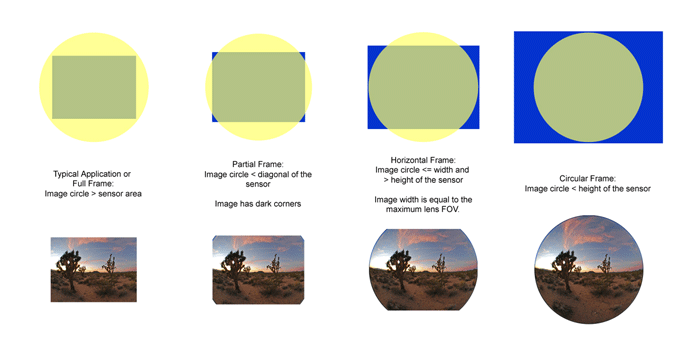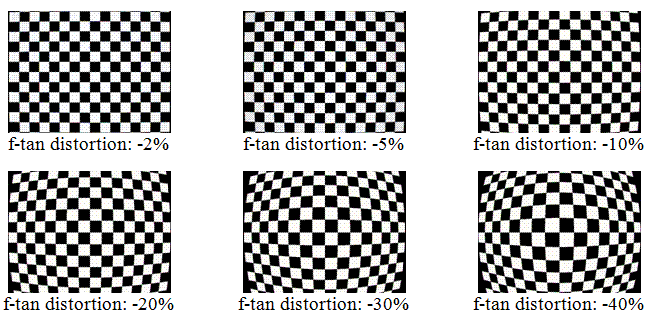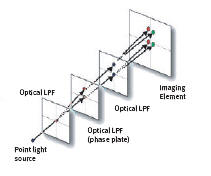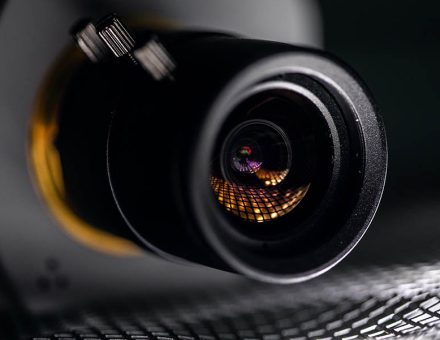Once the imager is chosen, the process for selecting an M12 lens (also called S mount lens) does not differ from that of selecting other CMOS lenses and consists of the following steps:
- Determine the desired field of view (in angles if the object is at infinity, and in actual sizes if the object is at a finite distance).
- Calculate the required focal length of the lens, and the image circle size. We have created a wizard to perform this calculation.
- Choose an appropriate lens f/# based on similar lighting environment and depth of field requirement. We have created a wizard to calculate the depth of field.
- Determine the appropriate lens performance requirements such as modulation transfer function (MTF), chromatic aberration, distortion, and relative illumination.
- Specify the mechanical size constraint and reliability requirements.
Imager format and resolution
The starting point is the format size which is linked to the effective area of the imager. The format size definition comes from pre-electronic imaging era. It does not directly represent the diagonal size of the effective area. Commonly seen imager formats and their actual physical sizes are listed below. The imager resolution is the number of effective pixels in the horizontal and vertical directions. The total number of pixels is often used to represent the nominal resolution of an imager.
Imager Format Approximate horizontal size (in mm) Approximate vertical size (in mm) Approximate diagonal
size (in mm)35mm full frame 36 24 43.3 APS-C 23.6 15.6 28.3 1.5″ 18.7 14.0 23.4 Micro 4/3rd 17.3 13 21.7 1″ 12.8 9.6 16.0 1/1.2″ 10.67 8 13.4 2/3″ 8.8 6.6 12.0 1/1.7″ 7.6 5.7 9.5 1/2″ 6.4 4.8 8.0 1/2.3″ 6.17 4.55 7.8 1/2.5″ 5.7 4.32 7.2 1/2.7″ 5.3 4 6.6 1/3″ 4.8 3.6 6.0 1/3.2″ 4.54 3.42 5.7 1/4″ 3.6 2.7 4.5 1/5″ 2.56 1.92 3.2 1/6″ 2.16 1.62 2.7 Lens image circle vs. imager size
- The max. image circle of a lens is the area over which the lens will provide an acceptable performance. For standard applications only lenses with image circle greater than the imager diagonal size should be selected (see below graphic). If the image circle is smaller than the imager diagonal black or darker corners will result. However, for ultra wide-angle systems, it is common to have the fisheye lens image circle smaller than the diagonal of the imager. If the entire image circle is contained within the effective area of the imager, a circular image is formed. If the imager circle is less than the horizontal width of the imager but greater than the vertical height, a horizontal frame is formed.

Effective focal length and field of view
Once lens image circle is determined, the next step is to determine the appropriate lens focal length (EFL) required to achieve the desired field of view. The lens EFL is an intrinsic property of the lens independent of the imager used. The max. lens field of view (FOV) is specified for the image circle size. However, the field of view of CCD/CMOS camera depends on both the lens EFL and the size of the imager area. If the lens distortion is small (known as rectilinear lenses), the following formula can be used to calculated the camera FOV:

- where x represents the width or height or diagonal size of the imager, and f is the lens EFL. We have created an online wizard to perform various FOV/EFL calculation. When there is a significant amount of distortion in the lens such as in the case of very wide-angle lenses and fisheye lenses, the calculation of the FOV is much more involved. We have developed a new concept called “rectilinearity” to characterize the distortion properties of ultra wide-angle and fisheye lenses. When used in conjunction with the effective focal length, the field of view and distortion property of a lens can be fully analyzed without having to know the detailed lens prescription.
Relative aperture or f/#
- The f/# of the lens has two impacts: (1) the amount of light that the lens collects, and (2) the depth of field (DOF). For low-light environment, it is often necessary to choose a lens with low f/#. However, the depth of field of a low f/# lens is limited. Low f/# lenses are also more complex and thus more expensive to produce. Therefore, the optimal f/# selection is based on the tradeoffs between various performance parameters and lens cost. It is usually possible to increase the f/#(stopping down the aperture) of an existing lens design without a detrimental impact on the image quality. However, lowering the f/# (increasing the aperture size) is usually not possible without causing a significant compromise in the image quality/relative illumination.
Nyquist frequency and image quality
- Aa digital imaging system the pixel array of the imager samples the continuous spatial image formed by the optical system. Nyquist Frequency (NF) represents the highest spatial frequency that the imager is capable of detecting. The NF depends on the pixel pitch, color filter array (CFA) design, and the processing algorithms of the entire imaging processing chain. Lens image quality can be the gating factor in the overall image quality of a digital imaging system. To realize the full resolution of the imager the lens resolution should be greater than the NF. The lens should provide sufficient spatial detail to the imager sensor if each pixel of the imager is to be fully utilized. Lens image quality is characterized by its modulation transfer function (MTF). The MTF of a lens varies with spatial frequency as well as angle of the incidence. A good lens should have MTF >40% up to the sensor Nyquist frequency. It should also provide a consistent MTF across the entire field of view of the lens.
Relative illumination and telecentricity
- The light collection ability of all lenses falls off with an increasing field of view. Relative illumination of a lens is defined as the ratio of light intensity at the maximum angle of view to that on-axis. For electronic imager sensors (CCD and CMOS), the off-axis brightness is further reduced by the collection efficiency of the imager pixel structure. Many modern imagers use a micro-lens over each pixel to increase the fill factor. The micro-lens will limit the field of view of the pixel. To be maximally compatible with the micro-lens field of view, the rays emerging from the lens must be within the acceptance angle of the micro-lens for all off-axis rays. This typically require that the primary lens be telecentric in imaging spacing. Non-telecentric lenses can also cause color and resolution cross-talk between adjacent pixels. This will further impair the off-axis performance of the imaging system.
Download a white paper on chief ray angle. Chromatic aberrations
- Optical materials have different indices of refraction at different wavelengths, known as dispersion. The material dispersion causes light at different wavelengths to focus at different focal plane (axial color) and different image height (lateral color). Lateral color can be seen as color fringes at high contrast edges of off-axis objects. Chromatic aberrations can be minimized or eliminated by using a combination of lens elements with different dispersion properties. Download a whitepaper on lateral color.
Distortion
- Lens optical distortion describes how the image is deformed with respect to the object. Distortion (%) is defined as follows:

where ychief is the image height for an off-axis chief ray, and yrefis a reference image height for the off-axis field angle. For normal field of view lenses, the reference image height is
defined as:
where f is the effective focal length and θ is the field angle. The resulting distortion is known as “rectilinear” or “f-tan” distortion. Most standard photographic lenses have low rectilinear distortion. For wide-angle and fisheye lenses, the reference image height is typically chosen as the product of focal length and field angle (in radians):

The resulting distortion is known as “f-theta” distortion. Please note that a zero f-theta distortion lens can still look very “distorted” visually. It is possible to “tailor” distortion in such a way that the off-axis resolution is enhanced from the standard “f-theta” type. Sunex has developed unique designs and manufacturing know-how to provide wide-angle lenses with tailored
distortion. We also provide Photoshop-compatible plug-in to “de-warp” images taken with tailored distortion lenses.
Visual impact of various lens distortion (value is calculated for the
corners)Depth of field or focus
- The depth of field (DOF) of a lens is determined by several factors: the relative aperture or f/#, the lens EFL, the maximum acceptable blur, and the lens MTF. Generally speaking, higher f/# lenses will have more DOF. Shorter EFL lenses will also have more DOF. We provide a wizard to calculate the depth of field for a given lens. If the MTF of the lens is higher, the perceived DOF will also be greater. Because the maximum allowed blur size is somewhat subjective and application dependent, it is strongly recommended that experimental verification of the DOF to be performed.
Flare, scattering and ghost images
- Flare is caused by improper engineering of the lens internal structure such that light rays outside the field of view is “leaked” into the normal field of view. Scattering is caused by the surface roughness of the lens element that causes an overall reduction in the contrast of the image. Ghost images are formed when light rays are bounced multiple times inside lens/sensor structure causing additional “weak” images to be formed near the primary image. These are all optical “noises” which can cause degradation to the overall image quality. Careful consideration must be
taken in the design and manufacturing processes to minimize the undesired optical noises. IR cut-off filter
- IR cut-off filtering in the optical chain is required to form accurate color images. IR cut-off filtering can be accomplished by inserting an IR-cut off filter in the lens system. Another option is to apply the IR cut-off coating onto the lens elements directly.
Optical low-pass filter (OLPF)
- The image formed by a lens is continuous in space. This image is “sampled” by a CCD/CMOS sensor with a sampling frequency equal to the inverse of the 2x pixel pitch. If the image contains objects at spatial frequencies higher than the sampling frequency of the imager, the resulting image will have aliasing artifacts. This phenomenon is often observed as colorful fringes (Moire fringes) on the final images. In high quality imaging systems, optical low-pass filters (OLPF) can be used to eliminate the Moire fringes. OLPF cuts off the lens MTF above the sampling frequency of the imagers resulting an overall MTF that approximates a step function (in spatial domain). Download an application note on OLPF.
An OLPF is made of 1 to 3 layers of optical birefringent materials such as quartz. Each birefringent layer splits a light ray by polarization as shown below:

Auto-focus (AF) lens
- Auto-focus lenses “track” the object continuously so that the image is always in-focus regardless of the object movement. This is done by adjusting the lens (typically using a step motor) to the imager distance based on measured real-time object distance.
Zoom lens
- A zoom lens is a lens that has variable effective focal length (EFL). Since the field of view of a lens is determined by its EFL, a zoom lens will have variable field of view. When the field of view is decreased, a “zoom-in” effect is observed. When the field of view of the lens is increased, a “zoom-out” effect is observed. In “zoom-in” position, the object detail is magnified but less area of the object is seen. In “zoom-out” position, more of the object area is observed but detail of the object is compromised.
View our webinar to learn more about the free tools Sunex’ provides to help pick the right lens for any project.


